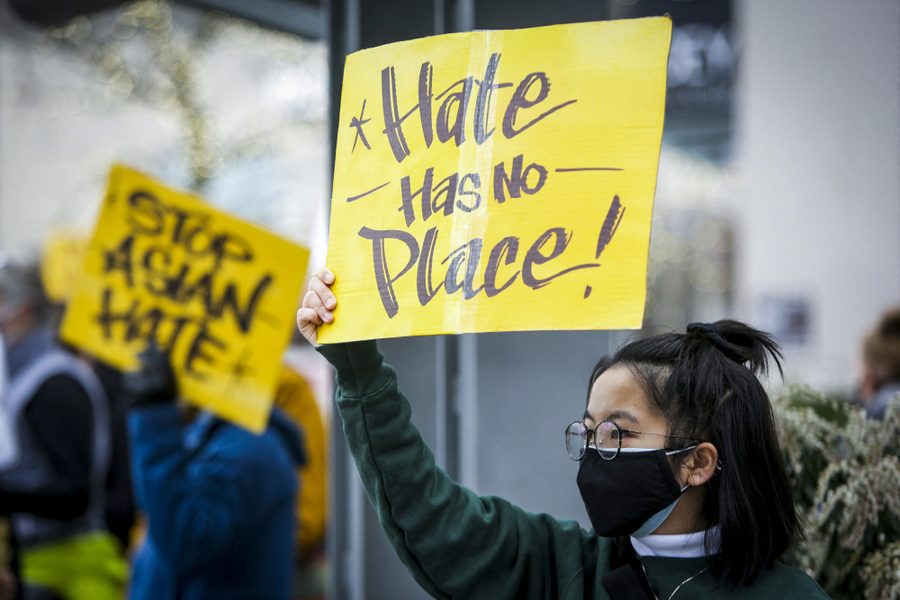I Deserve Meaningful Action From My University to Address Anti-Asian Hate
Northwestern students need more than empty statements. It’s time for institutional solutions.
Allison Arguezo

Every time I walk out the door, two words jump into my mind: “Chinese virus.” Beyond the fear of catching Covid-19, I’ve had to navigate the fear of being violently targeted because of my heritage.
I avoid people outside, noticing the looks they give me. I still don’t dare cough or sneeze in public. I grip my pepper spray, never knowing if I will need it.
These words have followed me even to places I never thought they could reach me, like my college campus. In April 2020, “Chinese virus” was graffitied over a rock originally decorated with Chinese characters at Northwestern University’s Lakefill area, which hugs the shore of Lake Michigan.
Within a week, the rock was painted over in black, and the greater Northwestern community soon forgot about the incident. Now, as I return to campus, it’s this silence that haunts me.
Despite the rise of hate crimes nationally and the incidents of anti-Asian sentiment reported in Evanston, Ill., Northwestern has not provided enough support for Asian American students.
Northwestern did release a statement in February condemning Asian American hate, pledging action against discrimination and referring students affected by anti-Asian hate to campus counseling services. Several Asian Pacific Islander Desi American (APIDA) student groups criticized the statement as “unhelpful and too forgiving of racism.” Other students expressed frustration over the limited availability and months-long wait times for counseling services — a program disproportionately staffed by white people, making some students feel unsupported.
The statement also calls readers to “learn about Asian and Asian American cultures, histories and arts” to combat racist ideologies, listing the Asian American Studies Program (AASP) as a resource. But because AASP is not an official campus department, it is underfunded with only seven faculty members. Well-supported petitions and meetings with the administration have yielded no major AASP changes.
Northwestern also lacks physical affinity and safe spaces solely for Asian American students. The Multicultural Center, which is shared by students of all marginalized backgrounds, was closed for the entirety of the 2020 – 21 academic year. The Multicultural Greek Council Lounge is the sole other similar physical space, but was only open for the year’s final academic quarter.
At the end of the 2020 fiscal year, Northwestern’s endowment stood at $11 billion. If Northwestern truly wants to advance the Asian American community, it must invest in its students, staff and departments. Just 1% of this endowment would mean more than $100 million to the cause.
Sadly, this misguided approach toward Asian American safety is not limited to Northwestern, but is seen in the federal government as well. The House passed a bill against anti-Asian hate, for example, which will make reporting hate crimes easier — but centers the solution in policing rather than tackling the root causes of racism. Non-police solutions would mean long-term dedication to the Asian American community at all times (not just after an incident), and fighting bigotry by challenging racist mindsets and ideologies.
At the university level, this investment in the community might look like building a physical space dedicated to Asian American students, where there would be no concern about taking space and resources from other communities in a shared building. This space could help improve students’ mental health while serving as a place to support and connect with one another. On a larger scale, a similar approach might look like community centers built in towns and cities to serve the broader Asian American community.
At Northwestern, investing in the AASP would bring on more professors and course offerings, giving Asian American students more opportunities to learn about their backgrounds and giving non-Asian students a way to learn about different cultures. Investment in more counseling services and hiring more diverse staff members could help students when hate crimes affect their well-being. Multifaceted, long-term diversity training for students and staff alike could help combat racial bias.
The Illinois state government has tallied one success where the federal government and Northwestern administration have failed. The community group Asian Americans Advancing Justice Chicago successfully pushed for a law which makes Illinois the first in the nation to require the teaching of Asian American history in public schools. This change is one step in the battle against racist ideologies. Highlighting the accomplishments of many prominent Asian figures will also spark discussions about the racial barriers Asian Americans face. It makes me joyous to know that Asian American students will grow up learning impactful stories centered around people who share their identity.
But until we see a broader institutional investment, all of the work to support the Asian American community will continue to come from the community itself, whether from student organizers or local activists. Because the institutions that have helped perpetuate this anti-Asian violence have done so little, Asian Americans have learned to lean on one another — but it is not the place of students and community leaders to fill in the gaps Northwestern and the federal government have left. We deserve meaningful action.
Allison Arguezo is a journalism and economics student at Northwestern University and an Editorial Intern at In These Times.





